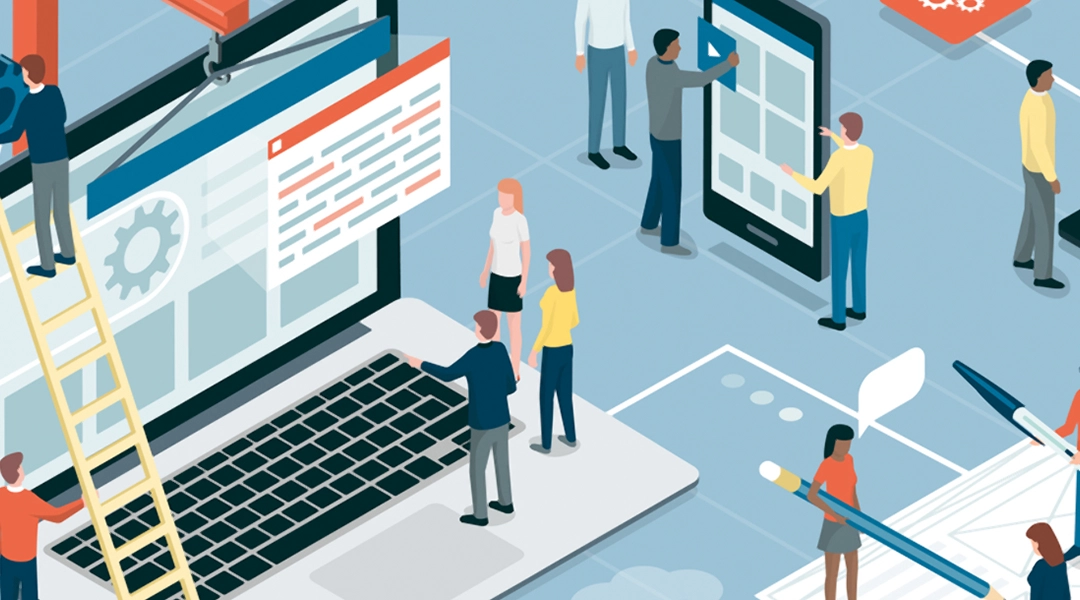Invest in research and get the planning right for your bespoke customer platform
Deciding to develop your own bespoke software/platform is a big step for any business, large or small. Get it right, and the rewards can be fantastic: increased productivity, improved employee/customer/client satisfaction, competitive edge, and increased revenue/profits, to name a few. Get it wrong, and the consequences can be costly. In this article, we’ll go through the steps you need to take when planning the development of a bespoke customer platform.
We are often asked how to approach such projects, and our answer is always “design for success”. In this series of articles, I look at what this means in practice by looking at techniques and tools that will support you in your journey, from the initial light bulb moment to happy, engaged users and tangible business benefits. We will also look at some real-world examples of successful and not-so-successful digital platforms to see what we can learn.
Designing for success
What do we mean by “Designing for success”? At its most basic level, this means approaching your project from start to finish with a design thinking mindset. It means taking an empathic, human-centric, pragmatic, and innovative approach backed up by sound research, testing and analysis, and informed decision-making. The key is in understanding the users of your proposed platform, both human and increasingly non-human, assessing and prioritising their problems and goals, and developing effective tools for them to achieve these goals.
Airbnb is one organisation that has successfully embraced design thinking by encouraging its team to experiment with ideas, test them and evolve the customer experience without the constraints of having to prove that the idea will scale first – this frees the team to be more creative in their approach.
On a practical level, there are many key steps in this journey, starting with an initial discovery phase to inform and moving into an iterative design and development cycle to create and refine a solution.
Understanding Users
Getting to know your users is key to success:
- Who are your users?
- What makes them tick?
- What are they trying to achieve?
- What frustrates them?
- What makes them happy/sad/angry?
- Why do they need to use your platform?
- What do they get from your platform?
Who are your users?
It’s easy to focus on one or two users and perhaps miss the bigger picture. Making a list of all potential users of your platform, including indirect and non-human users, will allow you to see the bigger picture and spot the project’s opportunities and risks. This includes business stakeholders who may not directly use the platform but will expect to see data, reports, and business results. It also includes IT/Customer Service staff who will be expected to support the platform and non-human users such as other applications and systems that need to interface with your platform.
What are they trying to achieve?
Once you have a list of all your users, you need to understand what they are trying to achieve. The best way to do this is to hold interviews and workshops with real users from each user type you have identified. Use this time to understand a few key areas:
Goals
Identify your users’ goals, i.e., why they will be using your platform or why they are funding your platform! Ask them to rank these goals in order of importance: what can they live without, and what is essential?
Frustrations
What makes it difficult for your users to achieve these goals? Are there common obstacles, pitfalls, and annoyances on the way to achieving them? Never underestimate the value in making just one thing easier / more pleasant repeatedly for your users!
Context
Find out about the context within which they will be using your platform:
- How are they feeling at the time?
- What constraints do they have (time, budgets, reliance on others)?
- Where are they (in the office, on a train, on the sofa)?
- Who are they with (colleagues, kids, strangers)?
It is surprising how often this exercise is left out, and yet when you do it, it’s amazing the insight that can be gained. This step will really enable you and your team to empathise with each user type.
Understanding the market
- What other platforms are there that are similar?
- What problems do these platforms solve?
- What do these platforms do well?
- Where do they fail?
- Could you use one of these platforms instead of building your own?
- Will you be competing with these platforms?
- What will be your USP?
- Are there common user journeys, interface components, and interaction patterns that your target market is familiar with using?
- What revenue models and price points do these platforms have?
Researching the market for competitor/similar platforms is a key task, but don’t be too focused on your own industry. There are many great insights to be gained from looking at similar tools aimed at different markets and noting what they do well and where they fail.
Developing a competitor feature matrix and evaluating this against your proposed features at an early stage will enable you to identify opportunities and risks giving you time to pivot before you’ve invested time and money.
What are the essential features of your platform?
Once you understand your business challenges, users, and the wider market, you should be in a position to identify key potential features for your platform. Now is the time to be ruthless and prioritise these into Must-haves, Should-haves, Could-haves, and Nice-to-haves. This prioritisation will allow you to focus on delivering the highest value features for your users and your business. It will provide you with other features that can be added to later phases of your development roadmap.
What KPIs and objectives will you use to measure success?
It seems obvious but is not always done! Targets and KPIs should be agreed upon early on when planning the development of a bespoke customer platform. . They should be measurable. The method of measurement should also be agreed upon with all stakeholders. Define KPIs that can be used during the course of the project and KPIs that will be used to define the final success of the project. Then use these KPI’s to create a framework for the ongoing monitoring of your platform’s performance.
- Common platform project KPIs include:
- Stages of the project delivered on time / within budget
- Client/stakeholder satisfaction as measured by defined survey
- Number of new users/sign-ups/referrals
- Time taken/saved to achieve a specified goal
- Revenue made/Money saved/Increased profit margin
- User satisfaction as measured by a defined survey
- Reduced number of support requests/complaints/reported bugs
Who will be designing and building your platform?
Deciding the best approach to resourcing your platform design and development will be dependent on several factors, including existing internal resources and capacity, relationships with existing suppliers, timelines, and budgets.
If you are considering outsourcing the design and build, be sure to put together a detailed RFP and invite several suppliers to respond before selecting a few for a chemistry meeting. Here, you can give them the opportunity to talk through their proposed approach and discuss risks, rewards, and outcomes.
What is your budget?
Developing your own platform is an investment. You will be developing something unique to your users, organisation, workflow, and requirements – and this will take time. Many businesses underestimate the investment required to successfully design, build, operate and maintain a bespoke platform, leading to failed projects or end-users burdened by poor user experience.
- Set aside a budget for the initial discovery phase of your project to define the potential deliverables for your platform.
- Get internal/external teams to quote for the design, build, and delivery of the platform.
- Develop a business plan that details the incremental revenue/savings you expect to make following the successful launch of your platform. Be sure to include costs such as marketing, training, support, and hosting, so that you can calculate the break-even point(s) for your investment.
Your platform will be a living project and will require ongoing investment for maintenance and the addition of new features, so setting out a roadmap for future investment should be a priority.
In the next article, Designing a customer platform – UX, UI & Design Systems, I look at key things to consider during your platform’s design phase. We will cover wireframing/prototyping and user validation, and UI design.















